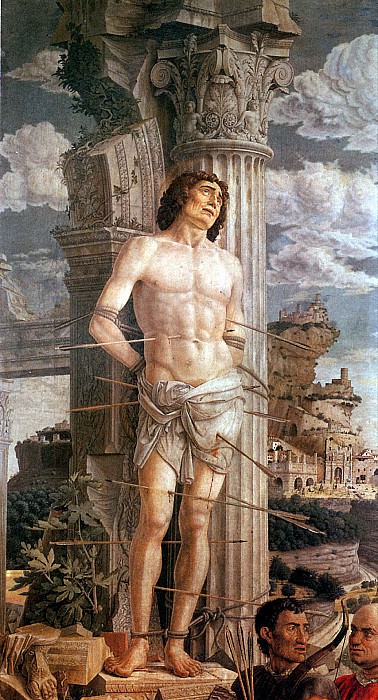MANTEGNA ANDREA – St. Sebastian, ca Louvre (Paris)
Louvre – MANTEGNA ANDREA - St. Sebastian, ca
Edit attribution
Download full size: 853×1583 px (0,5 Mb)
Back to album: Louvre (Paris)
Among Andrea Mantegna’s magnificent canvases on spiritual themes is a series of three paintings created at different times under the same title, "Saint Sebastian." The most famous of them is the second work of 1480, now in the Louvre. Sebastian is now a canonized saint, but earlier - between the 3rd and 4th centuries - a soldier of the legion and follower of Christian teachings. The ruling emperor Diocletian was against Jesus and his followers, severely persecuting them.
Description of Andrea Mantegna’s painting "Saint Sebastian
Among Andrea Mantegna’s magnificent canvases on spiritual themes is a series of three paintings created at different times under the same title, "Saint Sebastian." The most famous of them is the second work of 1480, now in the Louvre.
Sebastian is now a canonized saint, but earlier - between the 3rd and 4th centuries - a soldier of the legion and follower of Christian teachings. The ruling emperor Diocletian was against Jesus and his followers, severely persecuting them. When he learned that a preacher of the new faith had appeared among his legionaries, he ordered his companions to shoot the apostate with arrows to death.
As history reports, the Christian survived, his wife or another supporter of Christ walking out on him. The man continued the work of preaching, which led to a second execution. This time he was stoned to death and his body was thrown into a sewer in the city. At the instruction of an angel, the body was found by the Christian Lukina, who buried him in the catacombs.
The depiction of Sebastian’s martyrdom is a fairly common religious subject among painters. But each sees and shows viewers different facets of the man’s spiritual feat and its significance to history. Mantegna paints the saint as a manly man in 1480.
His entire lower torso is riddled with archers’ arrows. The legs are tied to a crumbling antique statue. This is a landmark symbol - the fall of Greco-Roman idols, the passing into oblivion of paganism. Near the "statue" of the martyr can be seen the remains of a completely destroyed marble hero. The slain man is strong, his eyes are faithfully directed towards heaven, his face is crisscrossed with wrinkles as evidence of wisdom and knowledge.
Mantegna paid much attention to detail in depicting the body, architecture, and background. The marvelous detail of the description recedes only before the ingeniously embodied idea of the formation of Christianity through the shedding of the blood of martyrs.
Кому понравилось
Пожалуйста, подождите
На эту операцию может потребоваться несколько секунд.
Информация появится в новом окне,
если открытие новых окон не запрещено в настройках вашего браузера.
You need to login
Для работы с коллекциями – пожалуйста, войдите в аккаунт (open in new window).




















COMMENTS: 1 Ответы
как жить, когда никто тебя не понимает... остаётся только здохнуть...
You cannot comment Why?